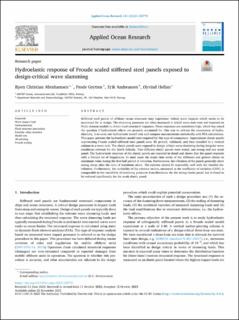| dc.contributor.author | Abrahamsen, Bjørn Christian | |
| dc.contributor.author | Grytten, Frode | |
| dc.contributor.author | Andreassen, Erik | |
| dc.contributor.author | Hellan, Øyvind | |
| dc.date.accessioned | 2024-01-24T11:51:18Z | |
| dc.date.available | 2024-01-24T11:51:18Z | |
| dc.date.created | 2023-12-12T14:52:11Z | |
| dc.date.issued | 2023 | |
| dc.identifier.citation | Applied Ocean Research. 2023, 141: 103774. | en_US |
| dc.identifier.issn | 0141-1187 | |
| dc.identifier.uri | https://hdl.handle.net/11250/3113562 | |
| dc.description.abstract | Stiffened steel panels of offshore ocean structures may experience violent wave impacts which needs to be accounted for in design. The slamming pressures are often measured in scaled wave tank tests and imposed on finite element models to obtain local structural responses. These responses are sometimes high, which has raised the question if hydroelastic effects are properly accounted for. One way to address the uncertainty of hydroelasticity, is to carry out hydroelastic model tests and compare measurements statistically with FEA calculations. This paper presents the hydroelastic model tests required for this type of comparison. Approximate elastic panels representing Froude scaled stiffened steel panels were 3D printed, validated, and then installed in a vertical column in a wave tank. The elastic panels were exposed to design critical wave slamming during irregular wave conditions relevant for the North Atlantic. Two different elastic panels were tested, one strong and one weak panel. The hydroelastic response of the elastic panels are reported in detail and shows that the panel responds with a limited set of frequencies. In most cases the strain time series of the stiffeners and girders obtain its maximum value during the first half period of vibration. Furthermore, the vibration of the panels generally show strong decay after the time of maximum strain. The extreme strains fit reasonably well with the Gumbel distribution. Furthermore, the variability of the extreme strains, measured as the coefficient of variation (COV), is comparable to the variability of slamming pressures from literature, for the strong elastic panel, but is found to be reduced significantly for the weak elastic panel. | en_US |
| dc.language.iso | eng | en_US |
| dc.publisher | Elsevier | en_US |
| dc.rights | Navngivelse 4.0 Internasjonal | * |
| dc.rights.uri | http://creativecommons.org/licenses/by/4.0/deed.no | * |
| dc.title | Hydroelastic response of Froude scaled stiffened steel panels exposed to design-critical wave slamming | en_US |
| dc.title.alternative | Hydroelastic response of Froude scaled stiffened steel panels exposed to design-critical wave slamming | en_US |
| dc.type | Peer reviewed | en_US |
| dc.type | Journal article | en_US |
| dc.description.version | publishedVersion | en_US |
| dc.rights.holder | © 2023 The Author(s). Published by Elsevier. | en_US |
| dc.source.pagenumber | 23 | en_US |
| dc.source.volume | 141 | en_US |
| dc.source.journal | Applied Ocean Research | en_US |
| dc.identifier.doi | 10.1016/j.apor.2023.103774 | |
| dc.identifier.cristin | 2212478 | |
| dc.relation.project | Norges forskningsråd: 294748 | en_US |
| dc.source.articlenumber | 103774 | en_US |
| cristin.ispublished | true | |
| cristin.fulltext | original | |
| cristin.qualitycode | 1 | |

